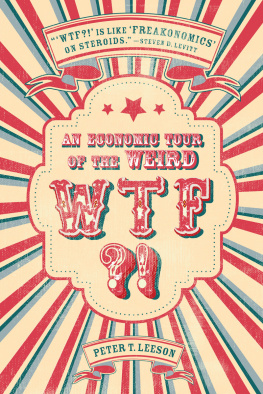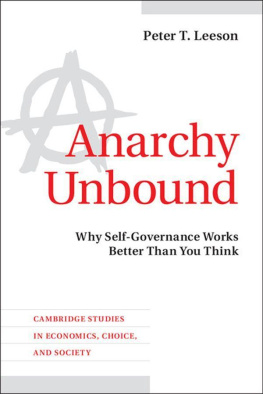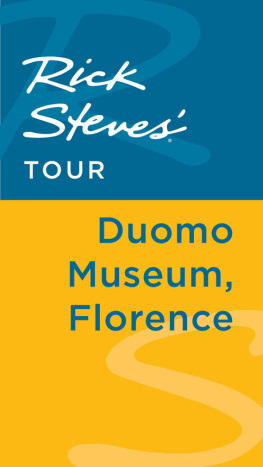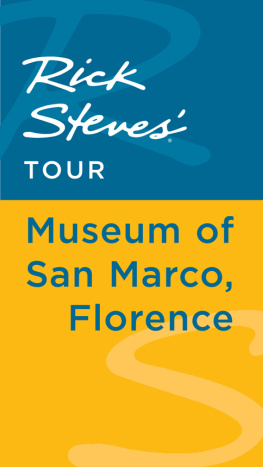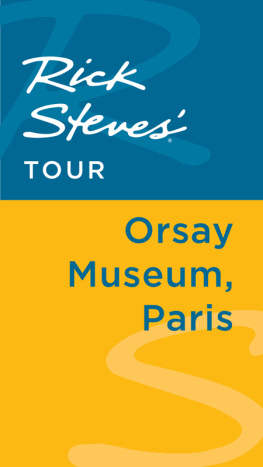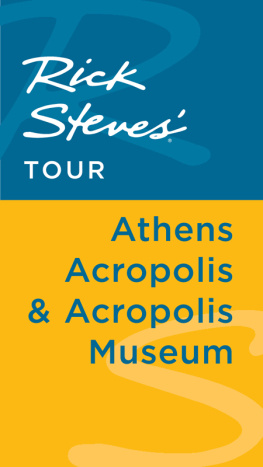Stanford University Press
Stanford, California
2017 by the Board of Trustees of the Leland Stanford Junior University. All rights reserved.
No part of this book may be reproduced or transmitted in any form or by any means, electronic or mechanical, including photocopying and recording, or in any information storage or retrieval system without the prior written permission of Stanford University Press.
Special discounts for bulk quantities of books in the Stanford Economics and Finance imprint are available to corporations, professional associations, and other organizations. For details and discount information, contact the special sales department of Stanford University Press. Tel: (650) 725-0820, Fax: (650) 725-3457
Printed in the United States of America on acid-free, archival-quality paper
Library of Congress Cataloging-in-Publication Data
Names: Leeson, Peter T., author.
Title: WTF?! : an economic tour of the weird / Peter T. Leeson.
Description: Stanford, California : Stanford Economics and Finance, an imprint of Stanford University Press, 2017. | Includes bibliographical references and index.
Identifiers: LCCN 2017015546 (print) | LCCN 2017017380 (ebook) | ISBN 9781503604490 (e-book) | ISBN 9781503600911 (cloth : alk. paper)
Subjects: LCSH: Manners and customs. | Economics. | Rational choice theory.
Classification: LCC GT95 (ebook) | LCC GT95 .L44 2017 (print) | DDC 390--dc23
LC record available at https://lccn.loc.gov/2017015546
Cover design by Christian Fuenfhausen
Typeset by Bruce Lundquist in 11/15 Adobe Garamond
WTF?!
An Economic Tour of the Weird
Peter T. Leeson
STANFORD ECONOMICS AND FINANCE
An Imprint of Stanford University Press
Stanford, California
For Stephanie, Mark, and Brenna
Precisely because the tyranny of opinion is such as to make eccentricity a reproach, it is desirable, in order to break through that tyranny, that people should be eccentric.
John Stuart Mill, On Liberty, 1859
Tour Stops
Waiting in the Lobby
Weird is how we describe things that dont make sense to usfrom Donald Trumps presidential victory to modern-day witch trials in Ghana to Kim Jong-uns haircut. Contemporary life is overflowing with weirdness. And yet historical life is weirder still. Consider human sacrifice among the Aztecs, self-immolation in eighteenth-century India, love magic in ancient Greece, cargo cults in midcentury Melanesia. On and on it goes. Its easy to get the feeling that life might be an unwitting tour of one big odditorium, that Ripleys Believe It or Not! is everywhere you turn.
Confronted with lifes weirdness, curious people wonder, Why? I developed the tour on which youre about to embark for just such people. Dont you mean book? youre wondering. No, I mean tour. Youre sitting in a museum lobby, and Im your guide. Well get there in a minute. But first, let me speak to why were gathered here.
To honor the grandest museum of oddities, our world, I decided some years ago that I wanted to showcase the weirdest practices that human history has to offer. What better way to share my exhibits than through an interactive tour? And thus began the construction of my museum of social oddities, bound up in the pages of this book but also reaching back into the depths of time and unfolding before you as you read.
The tour has eight stops. Just beyond the velvet rope, a few pages from here, is the first. That one isnt an exhibit; actually its more of a preparatory station: youre going to encounter some strange shit in this museum, so I want to make sure that you have the tools to handle it. The other stops are par for the museum course.
First, well look at trial by fire and water in medieval Europe. Next, wife selling in Industrial Revolution England. At the following stop, Gypsy superstitions. Then a brief intermission about cursing monks in eleventh-century Francia. Well look at oracular divination in twentieth-century Africa. Then on to the prosecution of insects and rodents in Renaissance France, Italy, and Switzerland. At our final stop, youll hear about judicial combat in Norman England. Now please squeeze together and make room for the incoming patrons. I hope you werent expecting a private tour (that would be much more expensive). You look like a lively bunch.
Turning to me, your guide: Im an economist by training but a collector of curiosa by, well, curiosity. Upon encountering a weird social practice I wonder, Why? But behind my wonder lies an openness to the possibilitya presumption, eventhat theres a good reason for whatever it is; theres sense in the seemingly senseless, I believe. And so Ive found it to be in the decade Ive been studying the specimens youre about to encounterand so many more.
Ive found that peopleall of them, regardless of time or place, religion or culture, wealth, poverty, or anything elseare rational. To be rational, as I see it, means simply to pursue your goals as best you can given your limitations and the limitations of your environment. In this form at least, the claim that people are rational isnt one that most will find hard to accept. Yet the immediate and certain implication is that people dont do senseless things.
One of this tours purposes is to show you that what seems like senseless behavior actually makes sense, and thus what seems like irrationality is actually rational. Weird social institutions strike you as weird because youre unfamiliar with the constraints that the people who developed them confront. But once you step into those peoples shoes and look at their worlds through their eyes, its easy to see that very unconventional practices reflect the canny pursuit of very conventional goalsones with which perfectly rational folks like yourself can commune.
If people are rational and rational people dont do senseless things, its not a step much further to conclude that the weird social practices people engage in are often good for their societies; they make them better off. Practices that make people worse off arent likely to survive. Which brings me to this tours second purpose: to show you how even seemingly senseless social practices can be, and often are, socially productive.
A particular approach to analyzing human behaviorthe economic approach, or whats sometimes called rational choice theoryis the perfect tool for accomplishing these goals because it starts, as I do, from the presumption that people are rational. After we leave the lobby, I wont explicitly discuss rational choice theory again apart from brief mentions at the tours first and last stops. I suspect most of you, quite reasonably, dont care about this theory per se. What you care about is finding compelling answers to the whys that accost your mind when you encounter weird behavior. Why cant you get full service at a gas station anywhereexcept New Jersey and Oregon, where youre forced to get it? Why is it harder to find good oranges at a grocery store in Florida than in Michigan? Why do you have to take out a second mortgage on your house if you want to shave with a halfway decent razor? And that brings me to this tours final purpose: to help you learn how to apply rational choice theory in your everyday life.
It can help you answer all of the questions Ive just posedand many more. In fact, if that theory were a physical device, it might be called the Incredible Answering Machinenot because it fields missed phone calls but because it can answer any Why? question about human behavior that life might throw at you. If rational choice theory were a physical device, it probably wouldve been hailed as one of humanitys greatest inventionsright along with your iPhone.
I stand before you a man transformed. I started my own journey into the world of social oddities wondering why it is that for centuries, criminal justice systems decided defendants guilt or innocence by asking them to plunge their arms into boiling water. I ended it concluding that shaking a poisoned chicken to decide how to behave toward your neighbors can be very wise. I have the answers. So if youre wondering Why? follow me. If youre not, check your pulse.
Next page
